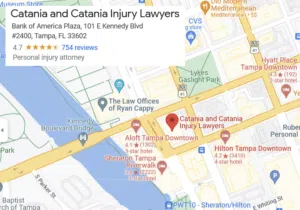
Evidence in a personal injury case is used to prove causation, negligence, and damages. It may include a variety of physical objects, written documents, and testimony. Without sufficient evidence to prove your case, you cannot recover compensation for your damages after an accident or injury.
Table of Contents
Types of Evidence Used in a Personal Injury Case

Florida rules of evidence determine the types of evidence you can present in court. Federal rules of evidence apply in a federal legal proceeding.
The evidence presented in a personal injury case may include:
Physical Evidence
Physical evidence is any object that relates to the allegations made by either party to a lawsuit.
For example, property damage to the vehicles is physical evidence in a car accident case. Torn carpeting may be evidence of a slip and fall accident. X-rays of objects left inside a patient could be evidence in a medical malpractice case.
Testimony
Testimony is an oral statement made by parties with knowledge of the case or facts relevant to the case. The parties to the case and eyewitnesses are often called to testify in personal injury cases. Expert witnesses may include specialists in a variety of fields.
Medical experts are often called to consult and testify in many personal injury cases to explain the extent of a person’s injuries or how an accident caused an injury. Financial professionals are called upon to calculate future damages, including ongoing medical costs, futures lost wages, and reductions in earning potential.
Accident reconstructionists and engineers may be called to help prove how a car accident occurred. Manufacturing and production experts may be called to testify in product liability cases.
Documentary Evidence
Documentary evidence is one of the most common types of evidence used in personal injury cases other than testimony. This type of evidence includes documents, photographs, videos, and audio recordings.
Examples of documentary evidence in a personal injury case may include, but is not limited to:
- Medical records, including records from physicians, ambulances, hospitals, therapy, counselors, rehabilitation centers, and pharmacies
- Police reports and accident reports
- Photographs and videos of the accident or the accident scene
- Wage and employment records, including tax returns, pay stubs, statements from an employer, bank records, and income statements
- Photographs of the person’s injuries
- Copies of maintenance records and repair records
- Information from a trucking company, such as logbooks, employment records, drug tests, etc.
- Copies of cell phone records
The documentary evidence varies by case. The documents used to prove fault and liability may be different based on the type of personal injury case.
Circumstantial Evidence
This is evidence that leads a person to make a reasonable assumption about an alleged matter of fact.
For example, suppose a text was sent about the same time that a driver rear-ended another vehicle. Because the only person in the vehicle was the driver and the cell phone was in the vehicle at the time of the crash, it can be assumed from cell phone records that the driver was texting.
Jurors may decide to believe circumstantial evidence instead of other evidence in the case.
Hearsay Evidence
Hearsay is typically not admissible in court. It is a statement made by someone outside of court. However, there could be some exceptions to the hearsay rule.
State Evidence
State evidence applies primarily in criminal cases. It is the testimony given by criminal defendants about other alleged criminals.
Using Evidence to Prove Legal Elements in a Personal Injury Case
The injured party has the burden of proof in a personal injury lawsuit. You must provide sufficient evidence to prove the legal elements. In most cases, negligence is the basis of an injury claim.
Therefore, you would need evidence proving:
- Duty of care
- Breach of duty of care
- Causation
- Damages
Jurors are the triers of fact. A juror may choose to believe or disbelieve any piece of evidence presented in court. The jurors weigh the evidence they accept as fact to determine whether to rule for the plaintiff or the defendant.
The burden of proof for a personal injury case is a preponderance of the evidence. The jury must find that there is a greater than 50 percent chance that the alleged claim is true. In other words, it is more likely than not the defendant caused the plaintiff’s injuries.
If you successfully meet the burden of proof, the jury may award an amount for non-economic damages and economic damages. Punitive damages may also be awarded in cases involving gross negligence or willful injury.
Schedule a Free Consultation With Our Tampa Personal Injury Lawyers
Injuries and accidents can turn your life upside down. Get help filing a personal injury claim from our experienced Tampa personal injury attorneys. Let us help you recover the money you deserve for your damages.




